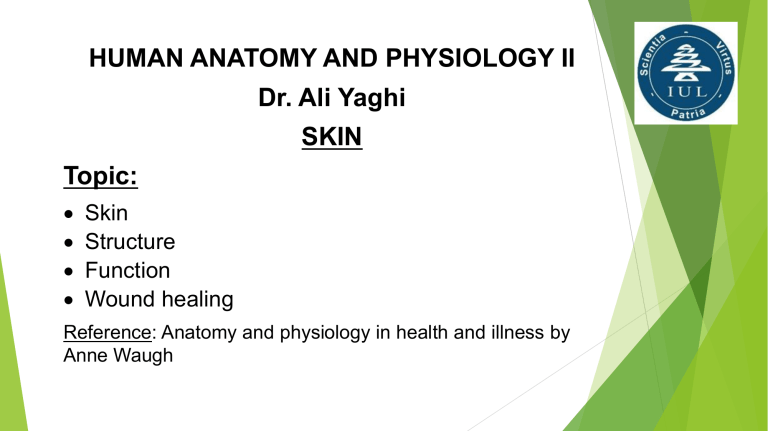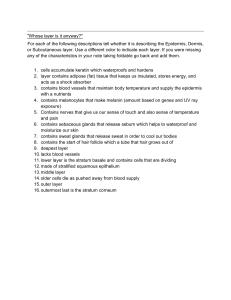
HUMAN ANATOMY AND PHYSIOLOGY II Dr. Ali Yaghi SKIN Topic: Skin Structure Function Wound healing Reference: Anatomy and physiology in health and illness by Anne Waugh The skin completely covers the body and is continuous with the membranes lining the body orifices. It: protects the underlying structures from injury and from invasion by microbes contains sensory (somatic) nerve endings of pain, temperature and touch is involved in the regulation of body temperature. STRUCTURE OF THE SKIN The skin is the largest organ in the body and has a surface area of about 1.5 to 2 m 2 in adults It includes glands, hair and nails. There are two main layers: the epidermis and the dermis. Between the skin and underlying structures is the subcutaneous layer composed of areolar tissue and adipose (fat) tissue. EPIDERMIS Is the most superficial layer of the skin Is composed of stratified keratinised squamous epithelium, which varies in thickness in different parts of the body. It is thickest on the palms of the hands and soles of the feet. There are no blood vessels or nerve endings in the epidermis, but its deeper layers are bathed in interstitial fluid from the dermis, which provides oxygen and nutrients, and drains away as lymph. There are several layers of cells in the epidermis which extend from the deepest germinative layer to the most superficial stratum corneum (a thick horny layer). The cells on the surface are flat, thin, non-nucleated, dead cells, or squames, in which the cytoplasm has been replaced by the fibrous protein keratin. These cells are constantly being rubbed off and replaced by cells that originated in the germinative layer and have undergone gradual change as they progressed towards the surface. Complete replacement of the epidermis takes about a month. Coloured scanning electron micrograph of the skin showing the superficial stratum corneum (pale brown), above the lower layers of the epidermis (pink) and the dermis (grey brown). The maintenance of healthy epidermis depends upon three processes being synchronised: desquamation (shedding) of the keratinised cells from the surface effective keratinisation of the cells approaching the surface continual cell division in the deeper layers with newly formed cells being pushed to the surface. The skin showing the main structures in the dermis. Skin color is affected by various factors: Melanin, a dark pigment derived from the amino acid tyrosine and secreted by melanocytes in the deep germinative layer, is absorbed by surrounding epithelial cells. It protects the skin from the harmful effects of sunlight. Exposure to sunlight promotes synthesis of melanin. Normal saturation of hemoglobin and the amount of blood circulating in the dermis give white skin its pink color. Excessive levels of bile pigments in blood and carotenes in subcutaneous fat give the skin a yellowish color. DERMIS The dermis is tough and elastic. It is formed from connective tissue and the matrix contains collagen fibers interlaced with elastic fibers. Rupture of elastic fibers occurs when the skin is overstretched, resulting in permanent striae, or stretch marks, that may be found in pregnancy and obesity. Collagen fibers bind water and give the skin its tensile strength, but as this ability declines with age, wrinkles develop. Fibroblasts, macrophages and mast cells are the main cells found in the dermis. Underlying its deepest layer there is areolar tissue and varying amounts of adipose (fat) tissue. The structures in the dermis are: blood vessels lymph vessels sensory (somatic) nerve endings sweat glands and their ducts hairs, arrector pili muscles and sebaceous glands. Sensory receptors in the skin Sensory receptor Meissner’s corpuscle Pacinian corpuscle Free nerve ending Stimulus Light pressure Deep pressure Pain SWEAT GLANDS Are widely distributed throughout the skin and are most numerous in the palms of the hands, soles of the feet, axillae and groins. Are formed from epithelial cells. The bodies of the glands lie coiled in the subcutaneous tissue. There are two types of sweat gland. The commonest type opens onto the skin surface through tiny pores, and the sweat produced here is a clear, watery fluid important in regulating body temperature. The second type opens into hair follicles, and is found, for example, in the axilla. The most important function of sweat, which is secreted by glands, is in the regulation of body temperature. Hairs Are formed by a downgrowth of epidermal cells into the dermis or subcutaneous tissue, called hair follicles. At the base of the follicle is a cluster of cells called the papilla or bulb. The hair is formed by multiplication of cells of the bulb and as they are pushed upwards, away from their source of nutrition, the cells die and become keratinised. ARRECTOR PILI These are little bundles of smooth muscle fibres attached to the hair follicles. Contraction makes the hair stand erect and raises the skin around the hair, causing ‘goose flesh’. Sebaceous glands These consist of secretory epithelial cells derived from the same tissue as the hair follicles. They secrete an oily substance, sebum, into the hair follicles and are present in the skin of all parts of the body except the palms of the hands and the soles of the feet. They are most numerous in the skin of the scalp, face, axillae and groins. It also prevents drying and cracking of skin, especially on exposure to heat and sunshine. The activity of these glands increases at puberty and is less at the extremes of age. Nails Human nails are equivalent to the claws, horns and hoofs of animals. They are derived from the same cells as epidermis and hair and consist of hard, horny keratin plates. They protect the tips of the fingers and toes. The root of the nail is embedded in the skin and covered by the cuticle, which forms the hemispherical pale area called the lunula. The nail plate is the exposed part that has grown out from the germinative zone of the epidermis called the nail bed. Finger nails grow more quickly than toe nails and growth is quicker when the environmental temperature is high. FUNCTIONS OF THE SKIN 1. Protection The skin forms a relatively waterproof layer, provided mainly by its keratinized epithelium, which protects the deeper and more delicate structures. As an important non-specific defense mechanism it acts as a barrier against: invasion by micro-organisms chemicals physical agents, e.g. mild trauma, ultraviolet light dehydration. The epidermis contains specialized immune cells called Langerhans cells, which are a type of microphage. The pigment melanin affords some protection against harmful ultraviolet rays in sunlight. 2. Regulation of body temperature Body temperature remains fairly constant at about 36.8°C across a wide range of environmental temperatures ensuring that the optimal range for enzyme activity required for metabolism is maintained. In health, variations are usually limited to between 0.5 and 0.75°C, although it rises slightly in the evening, during exercise and in women just after ovulation. To ensure this constant temperature, a negative feedback system maintains the balance between heat produced in the body and heat lost to the environment. Heat production When metabolic rate increases, body temperature rises, and when it decreases body temperature falls. Some of the energy released during metabolic activity is in the form of heat and the most active organs produce most heat. The principal organs involved are: skeletal muscles – contraction of skeletal muscles produces a large amount of heat and the more strenuous the muscular exercise, the greater the heat produced. Shivering also involves skeletal muscle contraction, which increases heat production when there is the risk of the body temperature falling below normal. the liver is very metabolically active, and heat is produced as a by-product. Metabolic rate and heat production are increased after eating. the digestive organs produce heat during peristalsis and during the chemical reactions involved in digestion. Heat loss Most heat loss from the body occurs through the skin. Small amounts are lost in expired air, urine and feces. Only heat loss through the skin can be regulated; heat lost by the other routes cannot be controlled. Control of body temperature The temperature regulating center in the hypothalamus is sensitive to the temperature of circulating blood. This center responds to decreasing temperature by sending nerve impulses to: arterioles in the dermis, which constrict decreasing blood flow to the skin skeletal muscles stimulating shivering. Activity of the sweat glands When body temperature is increased by 0.25 to 0.5°C the sweat glands secrete sweat into the skin surface. Evaporation of sweat cools the body, but is slower in humid conditions. Regulation of blood flow through the skin The amount of heat lost from the skin depends largely on blood flow through dermal capillaries. As body temperature rises, the arterioles dilate and more blood enters the capillary network in the skin. The skin is warm and pink in colour. If heat production is decreased, the arterioles in the dermis are constricted. This reduces the blood flow near the body surface, conserving heat. The skin appears paler and feels cool. Fever This is often the result of infection and is caused by release of chemicals (pyrogens) from inflammatory cells and invading bacteria. Pyrogens act on the hypothalamus, which releases prostaglandins that reset the hypothalamic thermostat to a higher temperature. The body responds by activating heat- promoting mechanisms, e.g. shivering and vasoconstriction, until the new higher temperature is reached. When the thermostat is reset to the normal level, heat-loss mechanisms are activated. There is profuse sweating and vasodilation accompanied by warm, pink (flushed) skin until body temperature falls to the normal range again. Hypothermia This means a core (e.g. rectal) temperature below 35°C. At a core temperature below 32°C, compensatory mechanisms to restore body temperature usually fail, e.g. shivering is replaced by muscle rigidity and cramps, vasoconstriction fails and blood pressure, pulse and respiration rates fall. Mental confusion and disorientation occur. Death usually occurs when the temperature falls below 25°C. Individuals at the extremes of age are prone to hypothermia as temperature regulation is less effective in the young and elderly. 3. Formation of vitamin D 7-dehydrocholesterol is a lipid-based substance in the skin, and ultraviolet rays in sunlight convert it to vitamin D. This circulates in the blood and is used, with calcium and phosphate, in the formation and maintenance of bone. 4. Cutaneous sensation Sensory receptors are nerve endings in the dermis that are sensitive to touch, pressure, temperature or pain. Stimulation generates nerve impulses in sensory nerves that are transmitted to the cerebral cortex. Some areas have more sensory receptors than others causing them to be especially sensitive, e.g. the lips and fingertips. 5. Absorption This property is limited but substances that can be absorbed include: some drugs, in transdermal patches, e.g. hormone replacement therapy during the menopause, nicotine as an aid to stopping smoking some toxic chemicals, e.g. mercury. 6. Excretion The skin is a minor excretory organ for some substances including: sodium chloride in sweat; excess sweating may lead to low blood sodium levels (hyponatraemia) urea, especially when kidney function is impaired aromatic substances, e.g. garlic and other spices. WOUND HEALING Conditions required for wound healing: Systemic factors: These include good nutritional status and general health. Infection, impaired immunity, poor blood supply and systemic conditions, e.g. diabetes mellitus and cancer, reduce the rate of wound healing. Local factors: Local factors that facilitate wound healing include a good blood supply to provide oxygen and nutrients and remove waste products, and freedom from contamination by, e.g., microbes, foreign bodies or toxic chemicals. PRIMARY HEALING (HEALING BY FIRST INTENTION) This method of healing follows minimal destruction of tissue when the damaged edges of a wound are in close apposition. There are several overlapping stages in the repair process. Stages in primary wound healing. STAGES: 1. Inflammation The cut surfaces become inflamed and blood clot and cell debris fill the gap between them in the first few hours. Phagocytes, including macrophages, and fibroblasts migrate into the blood clot: phagocytes begin to remove the clot and cell debris, stimulating fibroblast activity fibroblasts secrete collagen fibres which begin to bind the surfaces together. 2. Proliferation Epithelial cells proliferate across the wound, through the clot. The epidermis meets and grows upwards until full thickness is restored. The clot above the new tissue becomes the scab and separates after 3 to 10 days. Granulation tissue, consisting of new capillary buds, phagocytes and fibroblasts, develops, invading the clot and restoring the blood supply to the wound. Fibroblasts continue to secrete collagen fibres as the clot and any bacteria are removed by phagocytosis. 3. Maturation The granulation tissue is replaced by fibrous scar tissue. Rearrangement of collagen fibres occurs and the strength of the wound increases. In time the scar becomes less vascular, appearing after a few months as a fine line. The channels left when stitches are removed heal by the same process. SECONDARY HEALING (HEALING BY SECOND INTENTION) This method of healing follows destruction of a large amount of tissue or when the edges of a wound cannot be brought into apposition, e.g. varicose ulcers. The stages of secondary healing are the same as in primary healing and the time taken for healing depends on the effective removal of the cause and the size of the wound. Stages in secondary wound healing. Inflammation This develops on the surface of the healthy tissue and separation of necrotic tissue (slough) begins, due mainly to the action of phagocytes in the inflammatory exudate. Proliferation • This begins as granulation tissue, consisting of capillary buds, phagocytes and fibroblasts, and develops at the base of the cavity. It grows towards the surface, probably stimulated by macrophages. • Phagocytes in the plentiful blood supply tend to prevent infection of the wound by ingesting bacteria after separation of the slough. • Some fibroblasts in the wound develop a limited ability to contract, reducing the size of the wound and healing time. • When granulation tissue reaches the level of the dermis, epithelial cells at the edges proliferate and grow towards the center. Maturation • This occurs by fibrosis, in which scar tissue replaces granulation tissue, usually over several months until the full thickness of the skin is restored. • Scar tissue is shiny and does not contain sweat glands, hair follicles or sebaceous glands. Fibrosis (scar formation) • Fibrous tissue is formed during healing by secondary intention, e.g. following chronic inflammation, persistent ischaemia, suppuration or large-scale trauma. • The process begins with formation of granulation tissue, then, over time, the new capillaries and inflammatory material are removed leaving only the collagen fibres secreted by the fibroblasts. • Fibrous tissue may have long-lasting damaging effects. Adhesions These consist of fibrous tissue, which causes adjacent structures to stick together and may limit movement. THANK YOU







